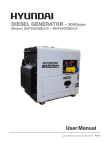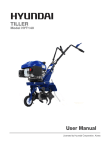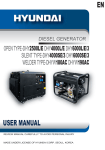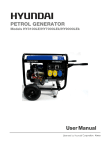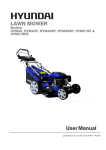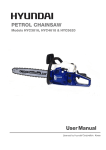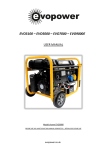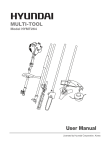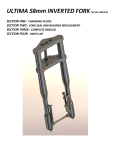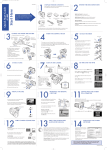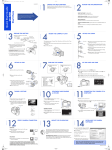Download and DHY8000SE(LR) User Manual
Transcript
DIESEL GENERATOR - 3000rpm Models DHY6000SE/LR – DHY8000SE/LR User Manual CONTENTS Section Description Page No/No’s 1. SAFETY 3-7 2. MACHINE LAYOUT 7-8 3. PREPARATION for STARTING 8 - 12 4. OPERATING THE GENERATOR 12 - 13 5. LOAD 13 -14 6. STOPPING THE MACHINE 14 – 15 7. PERIODIC MAINTENANCE 15 - 16 8. LONG TERM STORAGE 16 9. TROUBLE SHOOTING 17 10. SPECIFICATIONS 18 11. WIRING DIAGRAM 19 12. SERVICE RECORD SHEET 20 13. GENPOWER CONTACT DETAILS 21 14. DECLARATIONS OF CONFORMITY 22 Page 2 1. SAFETY. 1.1. The operator of the machine is; 1.1.1. Responsible for and has a duty of care in making sure that the machine is operated safely and in accordance with the instructions in this user manual. 1.1.2. Should never be left it in a condition which would allow an untrained or unauthorised person/s to operate this machine. 1.1.3. All due care and diligence should be taken by the operator for the safety of and with regard to those around whilst using the machine, to include but not limited to; 1.1.3.1. Elderly, children, pets, livestock and property. 1.2. Some or all of the following PPE, Warning Signs and symbols may appear throughout this manual and you must adhere to their warning/s. Failure to do so may result in personal injury. Personal Protective clothing (PPE) Warning Signs and Symbols Page 3 1.3. Carbon Monoxide 1.3.1. Carbon monoxide is a colourless and odourless gas breathing this gas. It can cause death as well as serious long term health problems such as brain damage. 1.3.2. The symptoms of Carbon monoxide poisoning can include the following; 1.3.2.1. Headaches, Dizziness, Nausea, Breathlessness, Collapsing or Loss of consciousness. 1.3.2.2. Carbon monoxide symptoms are similar to flu, food poisoning, viral infections and simply tiredness. That’s why it’s quite common for people to mistake this very dangerous poisoning for something else. 1.3.3. To avoid Carbon monoxide poisoning DO NOT Use Petrol/Diesel powered equipment inside a home or garage even if doors and windows are open. 1.3.4. If you think you or someone around you has been affected by carbon monoxide poisoning; 1.3.4.1. Get fresh air immediately. 1.3.4.2. Open doors and windows, turn off machine and leave the affected area. 1.3.4.3. See your doctor immediately or go to hospital - let them know that you suspect carbon monoxide poisoning. 1.3.5. DO NOT use in an enclosed area or a moving vehicle. 1.4. General fuel safety. 1.4.1. Fuel Safety additional information can be obtained from the Health and Safety Executive (HSE) document SR16. 1.4.2. All fuels are Flammable. 1.4.3. Keep away from all ignition sources i.e. Heaters, Lamps, sparks from Grinding or welding. 1.4.4. Hot work on tanks that have contained fuel is extremely dangerous and should not be carried out. 1.4.5. Keep work area clean and tidy. 1.4.6. Clean up all spills promptly using correct methods i.e. absorbent granules and a lidded bin. Page 4 1.4.7. Dispose of waste fuels correctly. 1.4.8. Diesel safety. 1.4.8.1. Always fuel and defuel in well-ventilated area. 1.4.8.2. Always wear correct, suitable and fit for purpose Personal Protective Equipment (PPE), suggested items are as follows, but are not limited too. 1.4.8.3. Hand protection. 1.4.8.4. Protective clothing. 1.4.8.5. Respiratory protective equipment should be used when in an unventilated area. 1.4.8.6. When defueling always use a propriety fuel retriever. 1.4.8.7. Always carry fuel in the correct and clearly marked container. 1.4.9. Petrol safety. 1.4.9.1. Always fuel and defuel in well-ventilated area. 1.4.9.2. Always wear correct, suitable and fit for purpose Personal Protective Equipment (PPE), suggested items are as follows, but are not limited too. 1.4.9.3. Hand protection. 1.4.9.4. Protective clothing. 1.4.9.5. Respiratory protective equipment should be used when in an unventilated area. 1.4.9.6. When defueling always use a propriety fuel retriever. 1.4.9.7. Always carry fuel in the correct and clearly marked container. 1.4.10. Electrical Safety. 1.4.10.1. Electricity can kill - never work on LIVE/ENERGISED equipment. 1.4.10.2. Identify electrical isolation method and always isolate all electrical supplies, prior to carrying out any maintenance work. 1.4.10.3. Prior to use and with all electrical supplies isolated check all electrical cables, plugs and connections for the following. 1.4.10.3.1. Are intact and have no signs of damage, to include but not limited to bare wires, chaffing, cuts and loose wiring. If there are any signs of damage, the damaged item should be taken out of service until the damage has been repaired by an electrically competent person. 1.4.10.4. All trailing cables should be routed so as not to cause any kind of trip hazard. Page 5 1.4.10.5. Never work on or near electricity with wet hands, wet clothing, and wet gloves. 1.4.10.6. Batteries present a risk if they become damage by the possible leaking of electrolyte. This electrolyte is an acid and can cause serious injuries. Care should be taken when working on or near them. 1.4.10.6.1. Should you come into contact with acid you should; 1.4.10.6.1.1. Remove all clothing contaminated with acid. 1.4.10.6.1.2. Get medical assistance as soon as possible. 1.4.10.6.1.3. Use fresh running water to wash off excess acid, continue this until medical assistance arrives. 1.4.10.6.1.4. If acid come into contact with Eyes the acid needs to be immediately washed away. Make sure that you do not wash the acid to another part of the face or body. 1.4.10.6.1.5. Gasses from charging batteries are highly flammable and great care should be taken to charge in well ventilated areas. 1.5. Additional Safety guidelines’ 1.5.1. Exhaust and Engine 1.5.1.1. The engine and exhaust will become very hot during use do not touch. 1.5.1.2. These items remain hot for some time after use. 1.5.1.3. Place the machine in an area where pedestrians or children are not likely to touch the machine. 1.5.1.4. Avoid placing any flammable materials near the exhaust outlet during operation. 1.5.1.5. Keep the machine at least 1 m from buildings or other equipment, or the engine may overheat. 1.5.1.6. Avoid operating the engine with a dust cover. 1.5.2. Control Functions 1.5.2.1. Oil Warning System 1.5.2.1.1. When the pressure switch senses low oil pressure engine will stop automatically. 1.5.2.1.2. Unless you refill with oil the engine will not start again. 1.5.3. Starter Switch (SW) 1.5.3.1. The engine starter switch controls the ignition. 1.5.3.2. In the ‘OFF’ Position the ignition circuit is switched off and the engine will not run 1.5.3.3. In the ‘ON’ position the engine is ready for starting 1.5.3.4. In the ‘START’ position (pushed against spring tension) the starter motor is engaged and the machine will start. Page 6 1.5.4. AC Switch (Breaker) 1.5.4.1. The AC Switch (Breaker) will turn ‘OFF’ automatically when the load exceeds the generator output. 1.5.4.2. If AC switch turns ‘OFF’ then before resetting remove some of the load and keep below the rated output of the machine. 1.5.5. DO NOT Connect the generator to Mains AC sockets in your building – commonly known as ‘back feeding’ it is extremely dangerous and illegal. 2. MACHINE LAYOUT Page 7 3. PREPARATION for STARTING DO NOT refill tank while engine is running or HOT. Do not smoke or allow flames or sparks in the area where the engine is refuelled or where the fuel is stored. Do not overfill the diesel tank and make sure the filler cap is securely closed after refuelling. Take care not to spill fuel when refuelling. If any fuel is spilled, make sure the area is clean and dry before starting the engine. Wear suitable PPE, suggested but not limited too 3.1. Selection and handling of fuel. 3.1.1. Selection of fuel. 3.1.1.1. Only use standard specification diesel, this can be red or white. 3.1.1.2. Keep dust and water out of the fuel. 3.1.1.3. When filling the fuel tank from drums, make sure that no dust or water is mixed in with the fuel. This can cause serious damage to the fuel injection pump or the injector nozzle. 3.1.1.4. Do not overfill. Overfilling can potentially be very dangerous. Diesel can expand in hot weather and overflow 3.1.1.5. Always leave a 25mm gap above the fuel level. Always check the engine oil level with the generator on a flat, level surface before starting or refilling the machine. Page 8 If an insufficient amount of engine oil is used, damage to the engine may result. Do not overfill the engine with oil. This generator is equipped with a low oil pressure switch this system will stop the engine automatically when the oil pressure falls below the minimum pressure required. This helps prevents damage such as bearing seizures etc. However, this should not be relied upon and the engine oil level should be checked and topped up if required, daily. Wear suitable PPE, suggested but not limited too 3.2. Check and refill the engine oil. 3.2.1. To ensure the generator maintains an optimum performance and the life of the generator is as long as possible, it is important to use the correct engine oil – SAE10W/30 – SAE15W/40 (API CH-4/CF/SJ/SL diesel engine oil or higher grade) and change after the first 20 hours, then every 100 hours. 3.2.2. If the correct engine oil is not used, or the engine oil is not replaced every 100 hours, as required, the risk of crankshaft bearing failure, piston seizure, piston ring sticking and accelerated wear of the cylinder liner, main bearing and failure of other moving components increases significantly. The generator lifespan will be greatly reduced if oil level and oil changes are reduced. 3.2.3. Remove oil filler cap and check engine oil level 3.2.4. If oil level is below the lower level line, refill with SAE API CH-4/CF/SJ/SL diesel engine oil on dipstick, or to the top of filler neck. N.B. do not screw oil filler in the oil filler cap when checking oil level. 3.2.5. Change contaminated oil. 3.3. Service the Air Cleaner. Page 9 Do not wash air filter with detergent. Replace the air filter if the engine output decreases or excessive exhaust smoke is noticed. Never run the generator without the air filter, otherwise rapid engine wear will result. 3.3.1. Remove the access panel to reveal air filter cover. 3.3.2. Undo the nut (anticlockwise) and remove the air cleaner cover and take out the element. 3.3.3. Clean the air filter. 3.3.4. Reattach the air filter cover and screw on the nut. 3.4. Checking the Generator before start up. Be sure to turn off the main breaker switch before starting. The generator should be earthed to prevent electric shocks. Turn off the main breaker switch and remove all loads. Before starting the engine, be sure to switch OFF any appliances connected to it. Ensure that the breaker switch is OFF before switching between 115v/230v. 3.5. Running-in periods of Operation. 3.5.1. The first 20 hours are the break-in period of the engine. For this reason, it is important to follow the following instructions during this period. 3.5.1.1. Warm up the engine 5 minutes after the initial starting, before applying load. 3.5.1.2. Avoid applying loads above 3kw during the first 20 hours of operation. 3.5.1.3. It is important to replace the engine oil on time. 3.5.1.4. Replace the engine oil whilst the engine is warm, after 20-hours running. 3.5.1.5. Ensure that old engine oil is drained out completely. Page 10 3.6. Battery. Do not connect tools or any other appliances to the generator before starting. Explosive gases are given off when charging battery. Only charge in a well-ventilated area, away from sparks and naked flames. 3.6.1. Battery. 3.6.1.1. When you first install the battery, ensure that the battery's polarity is the same as the generator's battery leads - Black = negative, Red = positive. 3.6.1.2. Using a voltmeter - check the voltage is 12.3V+, if lower, the battery must be charged. 3.6.1.3. Check that the voltage is correct every month. The battery should be between 12.5v and 13.6v. When the engine is running it should re-charge the battery. 3.6.1.4. Make sure battery is free from damage and is not leaking. If battery shows signs of damage or leaking – DO NOT continue to use. Instead replace battery immediately. 3.6.1.5. Make sure that all battery acid spills are correctly cleaned up straight away. 3.6.1.6. The battery should be stored in a charged condition. 3.6.1.7. The battery is a 12 volt 36Ah sealed lead acid battery and requires no maintenance other than; 3.6.1.7.1. Ensure battery terminals are; 3.6.1.7.2. Kept clean. 3.6.1.7.3. Kept tight. 3.6.1.7.4. Covered to prevent short circuiting. 3.6.1.8. If the battery voltage is too low, it will require charging before use. 3.6.1.9. Keep the battery in a cool, dry place. It is important to clean the battery every three months and charge every six months. Page 11 4. OPERATING THE GENERATOR Do not loosen or readjust either the engine speed limiting bolt or the fuel injection limiting bolt as this will cause the performance of the generator to be affected. 4.1. Starting. 4.1.1. Turn the main AC switch to the 'OFF' position. 4.1.2. Make sure that the machine has fuel for the task. 4.1.3. Make sure the emergency STOP switch is out (turn anti-clockwise). 4.1.4. Set the engine speed lever is set to ‘RUN’. 4.1.5. Turn the starting key clockwise to the 'START' position. 4.1.6. Remove your hand from the key as soon as the engine starts. 4.1.7. If the engine does not start after 10 seconds, wait 15 seconds before trying again. Excessive start attempts will cause the battery to flatten. 4.1.8. If it does not start after 3 attempts, or runs intermittently with excessive smoke check that the fuel system is fully primed. 4.1.8.1. Priming - before starting to prime make sure that there is fuel in tank and that you can contain any fuel spilt. 4.1.8.1.1. It is done by releasing the pipe clip on the diesel fuel line connected to the injector pump. Make sure you pinch the fuel line and then release slowly until all air is released and fuel appears. 4.1.8.1.2. When fuel appears replace pipe onto the injector pump and replace clip. Clear up any fuel spills before restarting. 4.1.8.1.3. The above may be necessary when new, or if the machine runs out of fuel. Page 12 4.1.9. Always leave the key in the ‘ON’ position whilst the engine is running. 4.1.10. Run machine for two minutes before applying load 4.1.11. Insert the plug into the socket you are about to use. 4.1.12. Turn the main AC switch to the 'ON' position and turn the electrical appliance ‘ON’. If the engine has been running, the muffler will become very hot. Be careful not to touch the muffler until it has had time to fully cool down. Never refuel the fuel tank whilst the engine is still running. 4.2. Checks whilst generator is running. 4.2.1. After each use make sure that there are no abnormal sounds or vibration. 4.2.2. Check that the engine is running smoothly normally. 4.2.3. Check that there is no excessive smoke form the exhaust after 10 minutes of running, and the engine has reached working temperature 4.2.4. Check that there are no oil or fuel leaks. If you notice any of the above, stop the engine and locate the fault. Please contact Genpower for assistance if required. Start appliances one-by-one. 5. LOAD 5.1. 230 Volt AC use. 5.1.1. After switching ON the main breaker switch, and the engine running check the Voltage reading when in ‘Voltage Mode’. It should read 230v ± 5% (50Hz). 5.1.2. The Digital panel only becomes active when the Main breaker is in the ‘ON’ position. The following will be displayed by successive presses of the ‘M’ or mode button. Page 13 Lamp Illuminated V Hz V1 V2 Indicating Voltage Frequency Event timer - or current running time (hours). This will reset to zero when main Breaker is 'OFF' Total Run Time 5.1.3. Connect the equipment to the generator in correct order. 5.1.4. Connecting the loads with the largest motor first, then the smaller items. 5.1.5. If the generator is overloaded the main breaker will trip. 5.1.6. To reset the breaker do the following; 5.1.6.1. Turn OFF and disconnect all loads. 5.1.6.2. Reset breaker, and add load onto the circuit to within 50% to 75% of rated output. 5.1.7. Wait a few minutes before resuming operation. 5.2. Electrical appliances, particularly motor driven equipment, will have a very high start-up current. The table below provides reference for connecting these appliances to the generator. Type Lighting Heating Appliance Fluorescent Lamp Motor Driven Equipment Wattage Starting Rated Typical appliance x1 x1 Incandescent lamp or heating appliance x2 x 1 to x 1.5 Fluorescent Lamp x 1 to 2 Refrigerator, Electric fan, Compressor or grinder x 3.5 Appliance Incandescent lamp 1000 watts Example Starting Rated 100 vA 100 vA Fluorescent Lamp 80 vA 40 to 60 vA Refrigerator 150 watts 450 to 750 vA 150 to 30 vA 6. STOPPING MACHINE Do not stop the engine suddenly or whilst under load. This can damage the AVR and cause damage to the alternator through overheating. Do not stop the engine with the decompression lever. Page 14 6.1. Switch OFF equipment connected to the generator. 6.2. Turn off the main breaker switch. 6.3. Run the generator without load for three minutes. 6.4. Turn the electric key start switch to the 'OFF' position. 6.5. Or press or pull down the stop lever. 7. PERIODIC MAINTENANCE Ensure the engine is off before performing any service. If the engine must be run, make sure that the area is well ventilated. The exhaust contains poisonous carbon monoxide gas. 7.1. Maintenance chart. All work/s should be carried out by a competent person – if you need technical advice contact Genpower First Every Every Every year month Item Daily 100 500 or 1000 or 20 hours hours hours hours Check and refill with diesel Yes Check and refill with engine oil Yes Check for oil leakage Yes Check and tighten fastening parts Yes Check and tighten head bolts Yes Yes First Replace engine oil oil Yes change Clean engine oil filter Yes Replace engine oil filter Yes Replace air filter Yes Replace fuel filter Yes Check Fuel injection pump Yes Check injector nozzle Yes Check fuel pipes Yes Yes – Adjust clearance of intake and exhaust valves Yes First time Grind intake/exhaust valves Yes Replace piston rings Yes Check battery condition Yes Check carbon brushes and slip rings Yes Page 15 7.2. Replacing engine oil. After engine has been run prior to changing the oil will be very hot. Wear correct PPE minimum of gloves and overalls. DO NOT allow any dust, dirt or any other debris enter oil or crankcase. 7.2.1. Remove the oil filler cap. 7.2.2. Remove the drain plug and drain the old oil while the engine is still warm. 7.2.3. The plug is located on the bottom of the cylinder block. 7.2.4. After draining, re-tighten the drain plug and refill with the recommended oil API CH-4/CF/SJ/SL diesel engine oil or higher grade. 8. LONG TERM STORAGE After running the engine the oil will be very hot. Wear correct PPE minimum of gloves and overalls. 8.1. If storing the generator for long periods of time, make the following operations. 8.1.1. Operate the engine for 10 minutes and then stop. 8.1.2. Stop the engine. 8.1.3. Drain the engine oil whilst the engine is still warm and refill with fresh oil. 8.1.4. Turn the engine for 2-3 seconds with the decompression lever set at the noncompression position and the starting key set at the 'START' position. (Do not start the engine.) 8.1.5. Wipe off the oil and dirt from the engine and store in a dry place. Page 16 9. TROUBLESHOOTING. 9.1. Troubleshooting - N.B. all corrective actions should be carried out by suitably qualified person/s. Problem The Diesel engine will not start The generator is not producing power Page 17 Possible fault/cause The governer lever is not at START position Emergency STOP button activated (depressed) Insufficient fuel Fuel injection pump does not deliver fuel or delivers insufficient fuel Check the engine oil level Remedy Set lever to START position Re-set emergency STOP button Refill with fuel Remove the injector pump and have it tested The specified oil level should be to the upper lever The injector has severe carbon Clean the injector build-up Check battery performance The start motor turns slowly and all connections Charge or replace with a new The battery is flat one Main breaker switch has not Turn the main breaker to the been turned ON ON position Alternator brushes worn Replace the brushes The contact in the socket is Make sure plugs are fully not good inserted into sockets The rated sped is too HIGH or Adjust engine speed to too LOW produce 52 Hz with no load AVR is damaged Replace AVR 10. SPECIFICATIONS Model Generator DHY6000SE Frequency Hz Continuous Output Power kW Max Power Voltage AC Volts Sockets Fuel Tank capacity (Litres) DC Output Volts Amps Battery Engine Type Engine Engine Power Output HP Start method Displacement cc Engine Speed rpm Lubrication Oil Weight - Dimensions Lubrication Oil Capacity (Litres) Power Factor cosᶲ Voltage Regulation Nett Weight kG Dimensions (L x W x H) mm DHY6000SE/LR DHY8000SE 50 Hz DHY8000SE/LR 4.5 kW 5.5 kW 5.2 kW 6.0 kW 115VAC/230VAC 16A + 32A @115V - 32A @230V 16 30 16 30 12V 8.3A 12 v 36Ah Diesel Hyundai D400, Forced AirHyundai D500, Forced Aircooled, OHV cooled, OHV 10 HP 12 HP Electric 418 cc 452 cc 3000 rpm SAE 10W/30 or 15W/40 (API CH-4/CF/SJ/SL diesel engine oil grade or higher) 1.75 Litres 1 Automatic Voltage Regulation - A.V.R. 152 935 x 520 x 765 156 935 x 545 x 835 154 935 x 520 x 765 160 935 x 545 x 835 Page 18 11. WIRING DIAGRAM 11.1. Page 19 (N.B. Subject to change without prior notice). 12. SERVICE RECORD SHEET Date Hours Maintenance undertaken Name Page 20 Page 21 13. GENPOWER CONTACT DETAILS 13.1. Postal address; Genpower Limited, Isaac Way, Pembroke Dock, Pembrokeshire, SA72 4RW, UK. 13.2. Telephone and Fax contact numbers; Office 13.3. Email contact; Technical 13.4. +44 (0) 1646 687880 [email protected] Web site; www.hyundaipowerequipment.co.uk Page 22 14. DECLARATIONS OF CONFORMITY 14.1. Genpower Ltd confirms that these Hyundai products conform to the following CE Directives; 14.1.1. 2006/42/EC Machinery Directive 14.1.2. 2004/108/EC EMC Directive 14.1.3. 2000/14/EC Noise Emissions Directive 14.1.4. 97/68/EC NRMM Emissions Directive 14.1.5. 2006/95/EC Low Voltage Directive Page 23 GENPOWER LTD Isaac Way, London Road Pembroke Dock, UNITED KINGDOM, SA72 4RW T: +44 (0) 1646 687 880 F: +44 (0) 1646 686 198 E: [email protected] www.hyundaipowerequipment.co.uk
























